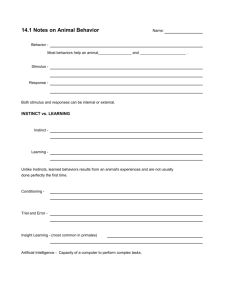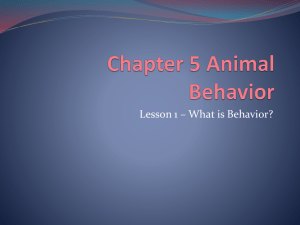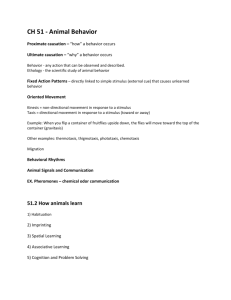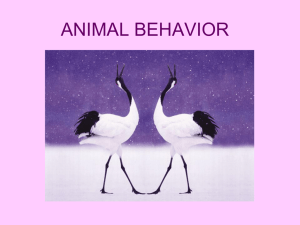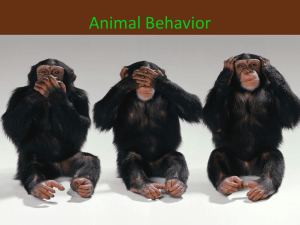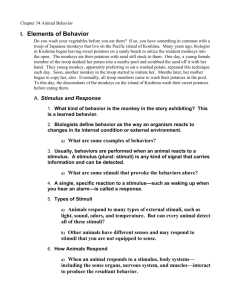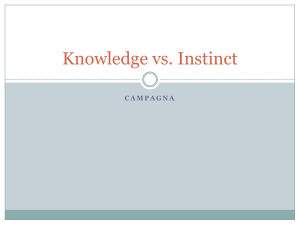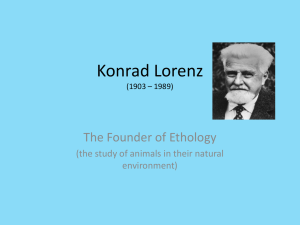Chapter 18
advertisement
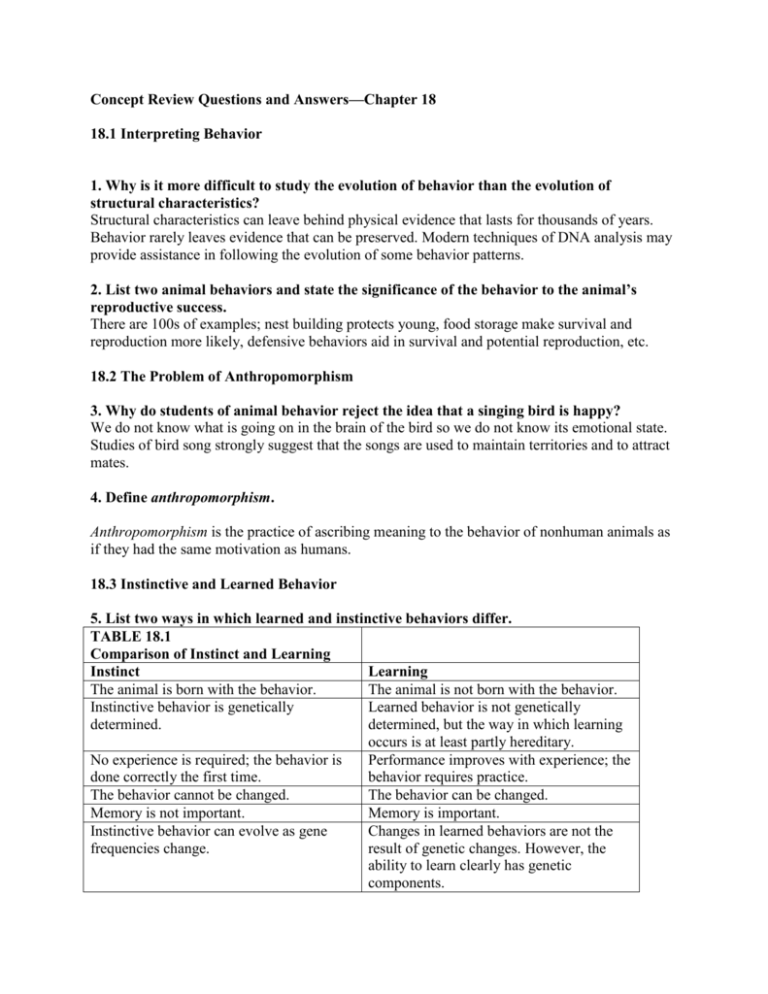
Concept Review Questions and Answers—Chapter 18 18.1 Interpreting Behavior 1. Why is it more difficult to study the evolution of behavior than the evolution of structural characteristics? Structural characteristics can leave behind physical evidence that lasts for thousands of years. Behavior rarely leaves evidence that can be preserved. Modern techniques of DNA analysis may provide assistance in following the evolution of some behavior patterns. 2. List two animal behaviors and state the significance of the behavior to the animal’s reproductive success. There are 100s of examples; nest building protects young, food storage make survival and reproduction more likely, defensive behaviors aid in survival and potential reproduction, etc. 18.2 The Problem of Anthropomorphism 3. Why do students of animal behavior reject the idea that a singing bird is happy? We do not know what is going on in the brain of the bird so we do not know its emotional state. Studies of bird song strongly suggest that the songs are used to maintain territories and to attract mates. 4. Define anthropomorphism. Anthropomorphism is the practice of ascribing meaning to the behavior of nonhuman animals as if they had the same motivation as humans. 18.3 Instinctive and Learned Behavior 5. List two ways in which learned and instinctive behaviors differ. TABLE 18.1 Comparison of Instinct and Learning Instinct Learning The animal is born with the behavior. The animal is not born with the behavior. Instinctive behavior is genetically Learned behavior is not genetically determined. determined, but the way in which learning occurs is at least partly hereditary. No experience is required; the behavior is Performance improves with experience; the done correctly the first time. behavior requires practice. The behavior cannot be changed. The behavior can be changed. Memory is not important. Memory is important. Instinctive behavior can evolve as gene Changes in learned behaviors are not the frequencies change. result of genetic changes. However, the ability to learn clearly has genetic components. Instinct is typical of simple animals with short lives and little contact with their parents. Instinctive behaviors can be passed from parents to offspring only by genetic means. Learning is typical of more complex animals with long lives and extensive contact with parents. Learning allows acquired behaviors to be passed from parents to offspring by cultural means. 6. Briefly describe an example of unlearned behavior in a particular animal. Explain why you know it is unlearned. There are hundreds of examples: egg rolling in geese—cannot be changed dancing in bees—cannot change and is not learned from parent gull chicks pecking at red spot on bill of parent—do behavior without previous experience 7. Briefly describe an example of learned behavior in a particular animal. Explain why you know it is learned. There are hundreds of examples: birds approaching cars and looking for bugs—could not have evolved since cars are recent inventions. pets coming to the kitchen when they hear the can opener—behavior changed with experience imprinting of young geese, ducks, chickens, etc., to follow parent—behavior develops after hatching 18.4 Kinds of Learning 8. Give an example of a conditioned response. Describe one that is not mentioned in this chapter. Most training of animals involves conditioned responses in which the animal is either negatively or positively re-enforced to elicit the correct response. For example, jerking a collar and saying “heel” can train an animal to respond by moving to the correct position when the verbal signal is given. 9. How are classical conditioning and operant conditioning different? Classical conditioning occurs when an involuntary, natural, reflexive response to a natural stimulus is transferred from the natural stimulus to a new stimulus. The response produced by the new stimulus is called a conditioned response. During the period when learning is taking place, the new stimulus is given before or at the same time as the normal stimulus. Operant (instrumental) conditioning involves the association of a particular outcome with a specific stimulus, but differs from classical conditioning in several ways. First, during operant conditioning the animal learns to repeat acts that bring good results and avoid those that bring bad results. Second, a reward or punishment is received after the animal has engaged in a particular behavior. Third, the response is typically a more complicated behavior than a simple reflex. A reward that encourages a behavior is known as positive reinforcement and a punishment that discourages a behavior is known as negative reinforcement. 10. What is imprinting, and what value does it have to the organism? Imprinting is a special kind of irreversible learning in which a very young animal is genetically primed to learn a specific behavior in a very short period during a specific time in its life. The time during which the learning is possible is known as the critical period. Behaviors such as following the parent have obvious protective value to offspring. 11. Give an example of habituation in a wild animal. There are many examples: Any continuous stimulus will eventually be ignored. Animals that are continually exposed to humans will ignore them. 12. In what kinds of animals is observational learning common? Observational learning is most common in animals that have long-term exposure to parents and other members of their species. This is particularly true for social animals that have extensive memory. 13. Why is insight difficult to demonstrate in animals? Insight involves mental manipulation of past experiences. This is nearly impossible to study in animals with which we cannot communicate complex ideas. 14. Give an example of the value of exploratory learning. An animal that is familiar with its surroundings is more likely to find food, shelter, and places to hide. 18.5 Instinct and Learning in the Same Animal 15. Which one of the following animals—goose, shark, or grasshopper—is likely to have the highest proportion of learning in its behavior? List two reasons for your answer. Geese are likely to have a high proportion of learning because they have large brains, live for a long time, and have long-term relationships with partners and offspring. 18.6 Human Behavior 16. Give examples of instinct, habituation, association, and imprinting in humans. Instinct: sucking behavior in infants Habituation: ignoring continuous sounds or sights Association: looking for green, red, yellow lights at a stop light—each color has a specific meaning associating specific smells with certain foods, etc. Imprinting: It is likely that language development involves imprinting. 18.7 Selected Topics in Behavioral Ecology 17. Describe why communication is important to successful reproduction. Communication is important in 1. finding mates, 2. communicating about willingness to mate 18. Describe two alternative strategies for assuring that some offspring will survive to continue the species. Produce lots of offspring and a few of them are likely to make it to reproductive age themselves. Produce a few offspring and protect, and feed them so they are likely to survive and reproduce. 19. How do territorial behavior and dominance hierarchies provide certain individuals with an advantage? Territorial behavior allows individuals to reserve resources for their use with little expenditure of energy to keep other organisms out of their area. Dominance hierarchies allow each organism in the group to recognize its position so that there is less conflict. Dominant organisms have easy access to resources. 20. What distinguishes societies from simple aggregations of individuals? Societies consist of groups in which there is division of labor and an orderly relationship among individuals. 21. How do animals use chemicals, light, and sound to communicate? Chemicals: odors and tastes can convey information about sexual status, threats, fear, etc. Light: sight allows colors, movements, etc., to be used to convey meaning Sound: can provide information about threats, solicitation for mates, etc. 22. What is sociobiology? Sociobiology is the systematic study of all forms of social behavior, both human and nonhuman.
